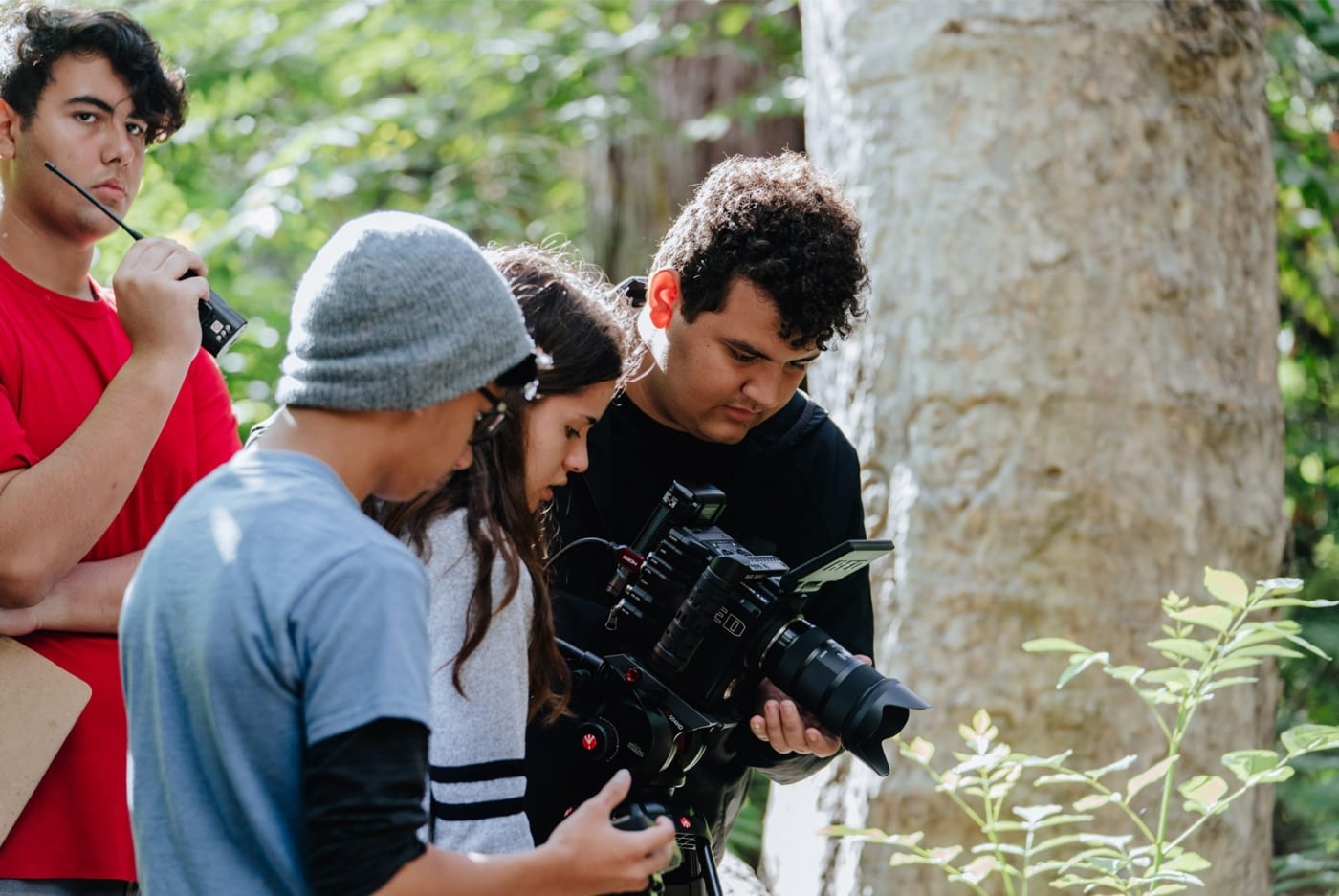
Before we get started it’s important to know that video in education isn’t just for media classes. If you’re a teacher who is interested in integrating video into your common core curriculum as a way to enhance learning, encourage collaboration, and foster critical thinking, you’re in luck. Video has never been as accessible as it is today. As you’re aware, most of your students are already using video to connect with one another. They’re also using it to get their information about the world and find their voices. The opportunity in our educational system is to use the technology they have at their fingertips to optimize the curriculum and prepare them for life after school.
The inflection point in how the masses receive information was catalyzed by the democratization of video. With such easy access to tools that were previously reserved for high-end Hollywood studios, everyone is now required to adopt skill sets that allow them to create video content wherever they are. For students, this is even more critical as they prepare for the workforce. They’re expected to bring an understanding of media and the basic tenets of visual storytelling. Providing a space outside of media classrooms to hone their technical skills and become more thoughtful communicators will uniquely position them for success, not only in their careers but also in their ability to learn and retain information in the classroom.
As educators, you have a front-row seat to the seismic shift taking place in how people communicate. Our suggestion is to start with where you probably are (Mobile Filmmaking) and evolve into a more advanced approach (Cinematic Filmmaking) as interest from students and funds from your district or grants become available.
We'll outline each focus below and we're always here if you have more questions or if you just want to chat about how other educators are adding visual storytelling in their curriculums. Please, don't hesitate to reach out!
Mobile Filmmaking 101: Introduction to Visual Communication
Perfect for all students, all teachers, all areas of the curriculum.
The most accessible entry point for integrating video in the classroom is to use the cameras students have on their phones.
Yes. You heard that correctly. Cell phones in the classroom aren’t just a tool for distraction. They can be the most helpful tool in allowing all students the opportunity to learn and engage in ways that used to be reserved for the elite. Even if you’re a school with no budget, it’s possible to integrate video content creation into every subject area. Allowing students to leverage devices they already have by turning them into storytelling tools in the classroom, bridges the divide between students and educators during this information inflection point.
The goal of the mobile approach to video in the classroom is to optimize the tools already at your disposal to enhance learning.
What life skills will students learn?
- Collaboration - Creating video content isn’t a solitary experience. Students (and teachers alike) learn to have constructive arguments, accept and translate feedback, and develop a posture of empathy through active listening.
- Project Management - When students are tasked with creating video content for any subject, they learn how to assemble locations, people and schedules. With a fixed amount of time to finish the project that requires a variety of variables, they have to learn organization skills in order to meet the deadline and communicate the content matter clearly.
- Communication - Students and educators learn how to piece together information in a clear and concise manner so that someone else can learn through images. Video is a practical way to communicate across socio-economic, cultural and language divides. In order for it to have an impact, students learn the critical life skill of effective communication.

Whatfilmmaking benefits will students experience?
- Budgeting - You can teach core concepts and give students a chance at learning critical communication skills for far less money than it has ever taken before.
- Iteration - With the accessible price point comes the luxury of failing quickly and cheaply. Students learn to develop their voices without being distracted by complicated gear or fear that failure will come at a tremendous financial cost.
- Post-production - Students will inherently learn an understanding of lighting composition, blocking, and crafting shots in a way that tells a good story. They will also learn the end-to-end process of capturing footage, editing and delivering a finished product to the intended audience.
Taking the mobile filmmaking approach to classroom education is a great way to make sure all students have an opportunity to leverage technology in order to retain more information and learn skills that will give them an advantage in the workplace. It’s also a great pathway to identify students who are natural storytellers. The money saved in the mobile filmmaking approach leaves room in your school’s budget for creating a space for the students who want to advance their storytelling skills.
To see an example of how mobile filmmaking worked for Chicago Public Schools, click here!
Cinematic Filmmaking 301: An Advanced Course In Video Production
Perfect for media, film, journalism and communication departments.
Finishing a film project used to require an immense amount of gear in order to build a studio-esque video workflow. In addition, post-production was a difficult and complicated process, making the art of teaching advanced filmmaking a slow and arduous process.
The advanced approach to incorporating video in the classroom is designed for the student who are interested in exploring visual storytelling professionally. This approach requires that the educator also has experience in the evolving area of video, media and visual arts. While access to higher-end technology for filmmaking has become more affordable, it is still a significant financial commitment for a school that often requires grants.
The goal of the advanced approach to video in the classroom is to teach an optimized approach to technical filmmaking.
What life skills will students learn?
- Leadership - Students who learn how to craft a story using more sophisticated gear and processes are uniquely positioned to enter the workforce with an advantage. Their time in the advanced classroom affords them the repetition necessary to develop their own style and voice. Those opportunities allow them to function at a higher level as content creators, leading teams, or even their own businesses.
- Problem Solving - The demand for people who can solve complex problems with fewer resources is not going away. Students who go through the advanced filmmaking classes will have spent time learning how to solve complex communication issues through visual storytelling while managing the variables necessary to complete the project.
- Perspective - Even if your students don’t choose an occupation in filmmaking, organizations from every industry are leveraging video as a way to communicate with their audiences. Messages often get lost in the minutia of pulling together a video shoot when teams aren’t familiar with the medium. The student’s ability to enter a job with higher-level knowledge of storytelling will be invaluable in helping their team members stay focused on the goal of the video because they won't be distracted by technical details. This perspective will be especially helpful to organizations that work with video teams regularly for brand awareness.
- Mastery - Here is a significant difference between an amateur chef and a professional chef. For anyone who truly wants to have a career in the video industry, being able to turn around content at a high level and knowing state-of-the-art workflows is the difference between being a starving artist and a working professional.

What filmmaking benefits will students experience?
- Streamlined Workflow - The advanced class teaches filmmaking techniques with approachable filmmaking and simplified workflows. Students learn to work with and deliver in 4K at a studio level by removing unnecessary technical barriers and automating processes. Instead of applying the complex workflow many professionals are trying to abandon, students will have the benefit of focusing on storytelling by leveraging professional gear within a new and simplified workflow.
- Efficiency - Raw media, 4K video, metadata, sound syncing, second source audio, and slates are all digitized now. Automating these processes to work together, shaves weeks off of the student’s filmmaking process even though they’re using professional gear. Instead of taking an entire semester just for post-production, educators can now teach it in a few weeks. It’s designed to work from end to end in a repeatable format so everyone saves more time, can produce more content. Students learn how to iterate at a lower cost and educators get to teach more advanced storytelling and critical thinking with the extra time saved.
Every step of this approach is designed to lead students into a deeper understanding of core filmmaking concepts. The lower-stakes environment gives them the opportunity to fail quickly and at a far less financial cost than previous generations. This generation of students has the advantage of retaining more information because of their access to iteration. They will be the most prepared to operate at higher levels when given professional gear outside of the classroom to create video content.
To see an example of how advanced filmmaking worked for Los Angeles Public Schools, click here!
Other topics you might like
LumaForge is now an OWC company!
Updated on Jan 14, 2021
What is Jellyfish Media Engine?
Updated on Dec 15, 2020
Kyno for Jellyfish - Better than Finder
Updated on Dec 15, 2020
Save time and money by future-proofing your video editing workflow
Updated on Dec 10, 2020
Is Final Cut Pro X for Hollywood?
Updated on Oct 27, 2020
Meet Your New Pre-Editing Process
Updated on Oct 19, 2020
Video Workflow: A Quickstart Guide
Updated on Oct 13, 2020
Video Marketing 101
Updated on Oct 7, 2020
Backup your Jellyfish to Backblaze B2 Cloud Storage
Updated on Sep 24, 2019








